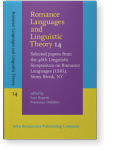Chapter 17
Romance evaluative que/che/să sentences as inverted optatives
Romance exclamative sentences introduced by the conjunctions que (Spanish, French, Portuguese) and che (Italian) ‘that’ and the Romanian particle să plus a subjunctive verb can receive an evaluative meaning and express the speaker’s displeasure or discontent about the propositional content. This paper describes and analyzes their properties. I propose that Romance que/che/să evaluative sentences are expressive sentences that express the speaker’s emotion about a proposition. The proposition is compared with other salient alternative propositions according to an inverted bouletic scale, so that the proposition is the less desirable for the speaker. The main formal properties (mood and tense restrictions) and semantic properties (presupposition of factivity and negative evaluation of the proposition) of the sentences naturally follow from the analysis.
Article outline
- 1.Introduction
- 2.Basic description of evaluative che/que/să romance sentences
- 2.1The form of che/que/să-Evaluatives
- 2.2Semantics and intonation of que/che/să-Evaluatives
- 2.3Summary
- 3.The analysis of que/che/să-Evaluatives as inverted optatives
- 3.1The expressive nature of que/che/să-Evaluatives
- 3.2The syntactic structure
- 3.3Tense restrictions and the contribution of Mood
- 3.4The factive presupposition and the subjunctive mood
- 4.Conclusions
-
Acknowledgements
-
Notes
-
References
